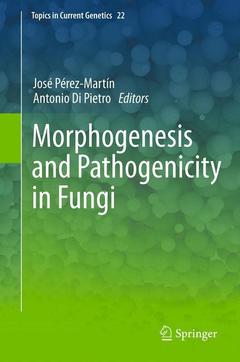Description
Morphogenesis and Pathogenicity in Fungi, 2012
Topics in Current Genetics Series, Vol. 22
Coordinators: Pérez Martín José, Di Pietro Antonio
Language: English
Subjects for Morphogenesis and Pathogenicity in Fungi:
Publication date: 02-2014
286 p. · 15.5x23.5 cm · Paperback
Publication date: 01-2012
286 p. · 15.5x23.5 cm · Hardback
Description
/li>Contents
/li>Comment
/li>
Infectious fungal diseases continue to take their toll in terms of human suffering and enormous economic losses. Invasive infections by opportunistic fungal pathogens are a major cause of morbidity and mortality in immuno-compromised individuals. At the same time, plant pathogenic fungi have devastating effects on crop production and human health. New strategies for antifungal control are required to meet the challenges posed by these agents, and such approaches can only be developed through the identification of novel biochemical and molecular targets. However, in contrast to bacterial pathogens, fungi display a wealth of ?lifestyles? and modes of infection. This diversity makes it extremely difficult to identify individual, evolutionarily conserved virulence determinants and represents a major stumbling block in the search for common antifungal targets. In order to activate the infection programme, all fungal pathogens must undergo appropriate developmental transitions that involve cellular differentiation and the introduction of a new morphogenetic programme. How growth, cell cycle progression and morphogenesis are co-ordinately regulated during development has been an active area of research in fungal model systems such as budding and fission yeast. By contrast, we have only limited knowledge of how these developmental processes shape fungal pathogenicity, or of the role of the cell cycle and morphogenesis regulators as true virulence factors. This book combines state-of-the-art expertise from diverse pathogen model systems to update our current understanding of the regulation of fungal morphogenesis as a key determinant of pathogenicity in fungi.
Molecular basis of morphogenesis in fungi.- Tropic orientation responses of pathogenic fungi.- Hyphal fusion.- Signalling of infectious growth in Fusarium oxysporum.- Integrating Cdk signaling in Candida albicans environmental sensing networks.- Cell cycle and morphogenesis connections during the formation of the infective filament in Ustilago maydis.- Appressorium Function in Colletotrichum orbiculare and Prospect for Genome Based Analysis.- Morphogenesis in Candida albicans: How to stay focused.- Morphogenesis in Paracoccidioides brasiliensi.- Morphogenesis of Cryptococcus neoformans.- Morphogenesis and infection in Botrytis cinere.- Morphogenesis, growth and development of the grass symbiont Epichlöe festucae.- Cryptococcus-neutrophil interaction.-
Covers a broad spectrum of taxonomically and biologically diverse fungal pathogens, plus a number of key topics related to morphogenesis and pathogenesis
Offers an in-depth and up-to-date analysis of the current state of knowledge on the subject
Written by experts in their respective fields
Includes supplementary material: sn.pub/extras




